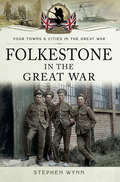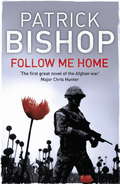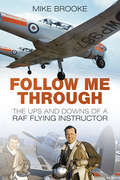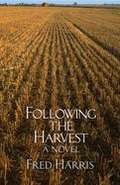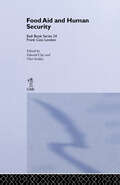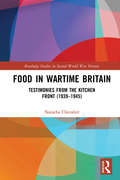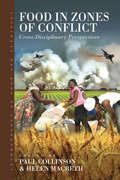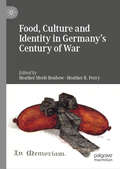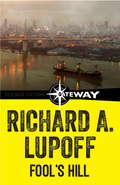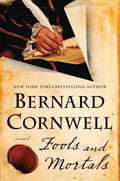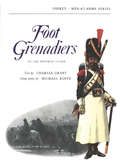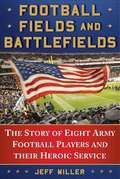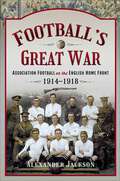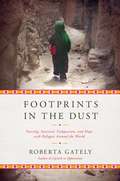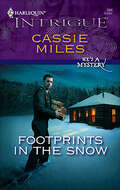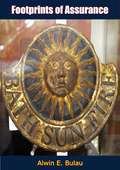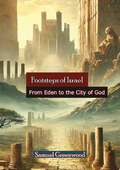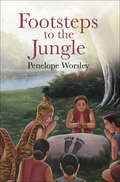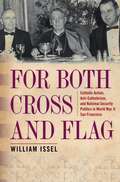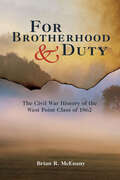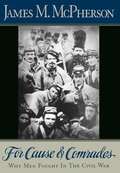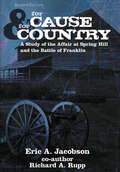- Table View
- List View
Folkestone in the Great War (Your Towns & Cities in the Great War)
by Stephen WynnFolkestone became one of the most important British towns during the First World War. Through its harbor, an estimated 10 million troops and nurses either departed from or arrived back in England between 1914 and 1919. For those leaving it was, for the most part, to fight on the battlefields of the Western Front. For those returning, it was either because they had been wounded or that they were coming home for some well-earned leave.Because of its geographical location along the south coast, the town was always going to be heavily involved in the course of the war. Shorncliffe camp saw the arrival of Canadian soldiers, infantry who had come to practice in its purpose-built trenches, and cavalry units who put their horses through their paces on its open grounds. As well as this, there was an influx of Belgian refugees who arrived in the town, having escaped the tyranny of an advancing Germany Army. Most stayed for the duration of the war, enjoying the hospitality and friendship of local people who had taken them in with open arms.With the town being a hive of military activity, the people of Folkestone went about their business as best they could. For many this included worrying about the well-being of a loved one who had gone off to fight in the war, hoping that they would remain safe but not knowing if they would ever see them again. It wasn't just on the Western Front, however, that death reared its ugly head. On one occasion it happened in Folkestone, in what has become known as the Tontines Street Air Raid. Seventy-one men, women and children were killed and another ninety-four were injured this German air raid, which took place on 25 May 1917. This book is a poignant testimony to those people as well as the men who didn't make it back
Follow Me Home
by Patrick BishopHigh summer in Helmand Province, Afghanistan.Two young soldiers, Milo and Zac, are on a mission which could really make their names. Their special duties team is to ambush and capture a notorious Taliban leader.The operation has been meticulously planned and set up. But suddenly - all is chaos.The hunters are now the hunted. To reach safety they must make their way through fifty kilometres of hostile territory, with a Taliban captive and a young, frightened woman in tow. Perilous at every turn, the journey is the biggest test any of them has ever faced, and it will change their lives forever.
Follow Me Through: The Ups and Downs of a RAF Flying Instructor
by Mike BrookeFollowing his success as a Cold War Canberra pilot, Mike Brooke was dispatched to become a flying instructor at the Central Flying School in the 1970s. ‘Follow him through’, as he would instruct his trainees, as he experiences the quite literal ups and downs of teaching the Glasgow and Strathclyde Air Squadron. Learn how he battled the diminutive de Havilland Chipmunk in order to teach others how to fly the aircraft, then finally moved to instructing on the Canberra in its many marks. Here Mike takes the reader on a quite often bumpy journey as an instructor of pilots old and new. There are tales of flying, near accidents and less serious incidents that flying these old but still demanding aircraft bring. Following on from his debut book, A Bucket of Sunshine, he continues to use his personal experience to bring aviation to life and prove indispensable for any aviation enthusiast.
Following the Harvest: A Novel
by Fred HarrisFollowing the Harvest is the latest novel by award-winning author Fred Harris, and tells the story of sixteen-year-old Will Haley, who journeys north in the summer of 1943 as a member of a wheat-harvesting crew. As the novel opens, Will excitedly prepares to leave behind his small hometown, family, and Saturday-night get-togethers with his friends down at the soda shop and to set out on the road with a cast of unforgettable harvest crew members. Although he is eager to begin his "moveable adventure," Will worries about taking care of his father, a dangerously heavy drinker, as they work their way north together. Traveling with his father, along with a humpbacked hired hand, a whiny truck driver and his pretty wife, two cousins from Mississippi, and his father's best friend, Will makes his way from Vernon, Oklahoma, to Rhame, North Dakota. Along the way he battles field fires and deadly weather, makes an unexpected visit to a house of ill repute, and takes a wild ride at the Frontier Days rodeo in Cheyenne, among other exploits. Will and the crew members work hard and play hard, but tensions run high as Will's father continues to drink heavily and the other crew members face their own demons and dilemmas. Not everyone will make the return trip to Oklahoma, and when an accident claims a crew member's life. Will is forced to take charge and become mature beyond his years. Set against the rich history and wide-open landscape of the Great Plains, Will Haley's coming- of-age story is both a touching and exhilarating read. His odyssey on the high plains is no less than an American epic.
Food Aid and Human Security (Routledge Research EADI Studies in Development #No. 24)
by Olav Schram Stokke Edward ClayFood aid is historically a major element of development aid to support longer-term development, and the primary response to help countries and peoples in crisis. This examination of food aid focuses in particular on institutional questions.
Food in Wartime Britain: Testimonies from the Kitchen Front (1939–1945) (Routledge Studies in Second World War History)
by Natacha ChevalierBased on deep analysis of Mass Observation wartime diaries, Food in Wartime Britain explores the food experience of the British middle classes in their own words throughout the course of the Second World War. It reveals that, while the food practices of the population were modified by rationing and food scarcity, social class and personal circumstances were key dimensions of the wartime food experience that demand to be taken into account in the historical narrative of the Home Front.
Food in Zones of Conflict: Cross-Disciplinary Perspectives (Anthropology of Food & Nutrition #8)
by Helen Macbeth Paul CollinsonThe availability of food is an especially significant issue in zones of conflict because conflict nearly always impinges on the production and the distribution of food, and causes increased competition for food, land and resources Controlling the production of and access to food can also be used as a weapon by protagonists in conflict. The logistics of supply of food to military personnel operating in conflict zones is another important issue. These themes unite this collection, the chapters of which span different geographic areas. This volume will appeal to scholars in a number of different disciplines, including anthropology, nutrition, political science, development studies and international relations, as well as practitioners working in the private and public sectors, who are currently concerned with food-related issues in the field.
Food, Culture and Identity in Germany's Century of War
by Heather Merle Benbow Heather R. PerryEven in the harsh conditions of total war, food is much more than a daily necessity, however scarce—it is social glue and an identity marker, a form of power and a weapon of war. This collection examines the significance of food and hunger in Germany’s turbulent twentieth century. Food-centered perspectives and experiences “from below” reveal the social, cultural and political consequences of three conflicts that defined the twentieth century: the First and Second World Wars and the ensuing global Cold War. Emerging and established scholars examine the analytical salience of food in the context of twentieth-century Germany while pushing conventional temporal frameworks and disciplinary boundaries. Together, these chapters interrogate the ways in which deeper studies of food culture in Germany can shed new light on old wars.
Fool's Hill
by Richard A. LupoffGENOCIDE - IN THE NAME OF LOVEAcross the planet, only a handful of giant, overcrowded, doomed cities exist - cities like Norcal, where multiple marriages are recommended and drug-taking is encouraged.Across the planet, everyone waits for the reclamation of a lost technology that can save them. Everyone, that is, except for the members of the Order of St Jerome in Norcal. The Order of St Jerome believes in peace, in morality, in two-person marriages and old-fashioned values. The trouble is, in the name of love the Order of St Jerome has decided to sacrifice the Earth...
Fools and Mortals: A Novel
by Bernard CornwellNew York Times bestselling author Bernard Cornwell makes a dramatic departure with this enthralling, action-packed standalone novel that tells the story of the first production of A Midsummer Night's Dream—as related by William Shakespeare’s estranged younger brother.Lord, what fools these mortals be . . .In the heart of Elizabethan England, Richard Shakespeare dreams of a glittering career in one of the London playhouses, a world dominated by his older brother, William. But he is a penniless actor, making ends meet through a combination of a beautiful face, petty theft and a silver tongue. As William’s star rises, Richard’s onetime gratitude is souring and he is sorely tempted to abandon family loyalty.So when a priceless manuscript goes missing, suspicion falls upon Richard, forcing him onto a perilous path through a bawdy and frequently brutal London. Entangled in a high-stakes game of duplicity and betrayal which threatens not only his career and potential fortune, but also the lives of his fellow players, Richard has to call on all he has now learned from the brightest stages and the darkest alleyways of the city. To avoid the gallows, he must play the part of a lifetime . . . .Showcasing the superb storytelling skill that has won Bernard Cornwell international renown, Fools and Mortals is a richly portrayed tour de force that brings to life a vivid world of intricate stagecraft, fierce competition, and consuming ambition.
Foot Grenadiers
by Charles Grant Michael RoffeThis book examines the uniforms, equipment, history and organization of Napoleon's Foot Grenadiers during the Napoleonic Wars (1799-1815). Their experiences at Ulm, Austerlitz, Berlin, in Russia and at Waterloo are all summarized. Uniforms are shown in full illustrated detail.
Football Fields and Battlefields: The Story of Eight Army Football Players and their Heroic Service
by Jeff MillerThe 2003 Army football team achieved futility in major college play that might never be equaled, losing all 13 of its games. The squad that took the field on a frigid December 2003 day in Philadelphia for the celebrated Army-Navy game featured only eight fourth-year seniors, just a slice of the fifty energetic freshmen—“plebes” in academy vernacular—who reported to West Point amid the heat and humidity of the summer of 2000, hoping to land spots on the football team. For most of the fifty, West Point represented their best—or only—opportunity to play major college football. They were bypassed by the big-time football schools that award athletic scholarships, which aren’t available at the nation’s military academies. Making a five-year active-duty military commitment following graduation was a small price to pay during peacetime. But peacetime in America ended only days into their second year at the academy, on September 11, 2001. Those eight seniors, like virtually all of their cadet peers, maintained their commitments to the US Army in the wake of 9/11. They worked their way up from West Point’s JV football team as freshmen, earned positions on the Black Knights’ varsity team as others left the program—voluntarily or otherwise—and walked to the center of the field for the coin toss before that final opportunity for victory, against the arch-rival Midshipmen. The football field then gave way to the battlefield. Most of the eight were deployed overseas, serving at least one tour in either Iraq or Afghanistan. One won the Bronze Star, another the Purple Heart. One qualified for an elite Rangers battalion, another for the 160th special operations aviation Night Stalkers. They took on enemy fire. They grieved at the loss of brothers in arms. They hugged their loved ones tightly upon returning home. There was no more talk of football losses. They were winners.
Football's Great War: Association Football on the English Home Front, 1914–1918
by Alexander JacksonAs modern football grapples with the implications of a global crisis, this book looks at first in the game’s history: The First World War. The game’s structure and fabric faced existential challenges as fundamental questions were asked about its place and value in English society. This study explores how conflict reshaped the People’s Game on the English Home Front. The wartime seasons saw football's entire commercial model challenged and questioned. In 1915, the FA banned the payment of players, reopening a decades-old dispute between the game's early amateur values and its modern links to the world of capital and lucrative entertainment. Wartime football forced supporters to consider whether the game should continue, and if so, in what form? Using an array of previously unused sources and images, this book explores how players, administrators and fans grappled with these questions as daily life was continually reshaped by the demands of total war. From grassroots to elite football, players to spectators, gambling to charity work, this study examines the social, economic and cultural impact of what became Football's Great War.
Foothold in Europe
by StrategicusOriginally published in 1945, this book is a study of World War II through the phase which marked the developing power of the Allies to the threshold of their great offensive which brought the enemy to final defeat. It opens with the failure of the Germans to forestall, or check, the tremendous Russian recoil and follows this offensive across the Ukraine into pre-war Poland and Rumania. It also marches with Montgomery and Clark into the 'Festung Europa' and moves across the Pacific on the first great stage of the return journey to the Philippines.Each of these campaigns is made up of a multiplicity of enthralling detail; and [...] each of these campaigns played its part in the overture to the great offensive.
Footprints in the Dust: Nursing, Survival, Compassion, And Hope With Refugees Around The World
by Roberta GatelyRoberta Gately is a nurse and humanitarian aid worker who has served in war zones ranging from Africa to Afghanistan aiding refugees. Just the word refugee sparks conversation and fuel emotion. There are more than 22 million refugees worldwide and another 65 million who have been forcibly displaced. But who are these people? Images filter into our consciousness via dramatic photographs—but these photos only offer a glimpse into their stories. Footprints in the Dust aims to share the real stories of these refugees in hopes of revealing the truth about their experience. As a young ER nurse in Boston, Roberta was stopped cold by stark images of big-bellied babies with empty haunting stares in the news. She called the aid organization featured in the news story and within two months, she was on her way. Roberta would soon learn that world into which millions of children around the globe were born was fraught with unspeakable horrors. The only certainties for so many of these children were, and remain to this day—disease and devastating injury.Footprints in the Dust reveals the humanity behind the headlines, beginning where the newscasters end their reports. The people we meet within this riveting book are neither all saints nor all sinners—and impossible to forget.
Footprints in the Snow (He's a Mystery #1)
by Cassie MilesA beautiful scientist in the Rocky Mountains is rescued by a WWII-era soldier in the USA Today–bestselling author’s suspenseful time travel romance.Geologist Shana Parisi is enjoying the natural wonders of the Rocky Mountains when a powerful blizzard catches her off guard—and thrusts her back in time to the 1940s. Sergeant Luke Rawlins of the 10th Mountain Division rescues her from danger, but it’s the mesmerizing look in his eyes that captures her heart . . . and forges their destiny.Luke knows bringing the beautiful Shana back to his cabin poses a threat to his secrets, but a foreign enemy is hot on their trail and Shana’s snowy footprints are all they need to track her down. Once entrenched in his world, Luke urges her to remain silent about what she saw. Because the alternative could be deadly. . . .
Footprints of Assurance
by Alwin E. BulauFOOTPRINTS OF ASSURANCE is a comprehensive and complete record of fire marks used by fire insurance companies in sixty-three countries. These insignia themselves tell the story of the development of one of the world’s most important economic institutions.Mr. Bulan enriches the story by introducing the reader to some of the men who have been responsible for the growth of the institution. He has enlivened his account with incident and anecdote so that the lay reader may share with the profession an understanding of the spirit which has from the beginning been the distinguishing feature of the enterprise of providing security against loss by fire.Collectors of fire marks will find this volume to be an indispensable guide. Economic historians will not find anywhere so full a record of these signs of security, these visible symbols of assurance, assurance which provided the climate requisite to economic growth.The volume shows nearly 1800 fire marks in half tone vignettes each with a caption giving a full description of the mark and date of organization of each company. This systematic treatment has indeed established the collecting of marks as a science and has added to the English language the word Signeviery as the name of that science.
Footprints on the Sands of Time: RAF Bomber Command Prisoners of War in Germany 1939–1945
by Oliver Clutton-BrockThe author of RAF Evaders provides a comprehensive reference of the airmen of Bomber Command who were held in German captivity during WWII. This extensive book is divided into two part. The first, which has eighteen chapters, deals with German POW camps as they were opened, in chronological order and to which the Bomber Command POWs were sent. Each chapter includes anecdotes and stories of the men in the camps—capture, escape, illness, and murder—and illustrates the awfulness of captivity even in German hands. Roughly one in every twenty captured airmen never returned home. The first part also covers subjects such as how the POWs were repatriated during the war; how they returned at war&’s end; the RAF traitors; the war crimes; and the vital importance of the Red Cross. The style is part reference, part gripping narrative, and the book will correct many historical inaccuracies, and includes previously unpublished photographs. The second part comprises an annotated list of ALL 10, 995 RAF Bomber Command airmen who were taken prisoner, together with an extended introduction. The two parts together are the fruit of exhaustive research and provide an important contribution to our knowledge of the war and a unique reference work not only for the serious RAF historian but for the ex-POWs themselves and their families and anyone with an interest in the RAF in general and captivity in particular.
Footsteps of Israel: From Eden to the City of God
by Samuel GreenwoodFootsteps of Israel: From Eden to the City of God by Samuel Greenwood offers a sweeping narrative of humanity’s spiritual journey, tracing the biblical story of Israel from the creation of Eden to the ultimate fulfillment of divine promises in the City of God. Greenwood’s work is both a historical reflection and a theological exploration, weaving together themes of faith, redemption, and God’s enduring covenant with His people.The book examines the key moments in Israel’s history, starting with the fall of humanity in Eden and progressing through pivotal events such as the calling of Abraham, the Exodus from Egypt, the reigns of the kings, and the prophetic promises of restoration. Greenwood emphasizes how each step of Israel’s journey reflects universal spiritual principles, showing how God’s guidance and grace are available to all people, not just one nation.Greenwood delves into the deeper meaning of Israel’s struggles, triumphs, and failures, drawing lessons applicable to modern believers. He presents Israel’s story as a spiritual metaphor for the progress of every soul—from the challenges of sin and exile to the hope of reconciliation with God. Throughout the book, Greenwood also reflects on the ultimate promise of the City of God, a symbolic representation of divine harmony and the fulfillment of God’s plan for humanity.Written with clarity and reverence, Footsteps of Israel appeals to readers interested in biblical history, theology, and the journey of faith. It offers a hopeful message, emphasizing that the spiritual truths revealed through Israel’s story remain relevant to believers today. Greenwood’s work invites readers to view their own lives as part of a greater spiritual pilgrimage, encouraging them to walk in faith toward the City of God—a place of peace, renewal, and eternal connection with the divine.
Footsteps to the Jungle
by Penelope WorsleyBorn in Cairo in 1942, Penelope married Oliver Worsley and went to live in Yorkshire, where they had four children. Footsteps to the Jungle traces Penelopes earlier life, the discovery of Huntingtons Disease, the death of her son Richard and what led her to set up an international charity in his memory. The Karen Hilltribes Trust is focused on helping the Karen people in the mountainous area of northwest Thailand to help themselves to build a better future. This illustrated book is a personal story that shares tragedy, illness and challenges, resulting in the huge rewards of working with others
For All We Have and Are: Regina and the Experience of the Great War
by James M. PitsulaThe First World War profoundly affected every community in Canada. In Regina, the politics of national identity, the rural myth, and the social gospel all lent a distinctive flavour to the city’s experience of the Great War. For many Reginans, the fight against German militarism merged with the struggle against social evils and the “Big Interests,” adding new momentum to the forces of social reform, including the fights for prohibition and women’s suffrage.James M. Pitsula traces these social movements against the background of the lives of Regina men who fought overseas in battles such as Passchendaele and Vimy Ridge. Skillfully combining vivid detail with the larger social context, For All We Have and Are provides a nuanced picture of how one Canadian community rebuilt both its realities and myths in response to the cataclysm of the “war to end all wars.”
For Both Cross and Flag: Catholic Action, Anti-Catholicism, and National Security Politics in World War II San Francisco
by William IsselIn this fascinating, detailed history, William Issel recounts the civil right abuses suffered by Sylvester Andriano, an Italian American Catholic civil leader whose religious and political activism in San Francisco provoked an Anti-Catholic campaign against him. A leading figure in the Catholic Action movement, Andriano was falsely accused in state and federal Un-American Activities Committee hearings of having Fascist sympathies prior to and during World War II. As his ordeal began, Andriano was subjected to a hostile investigation by the FBI, whose confidential informants were his political rivals. Furthermore, the U. S. Army ordered him to be relocated on the grounds that he was a security risk. For Both Cross and Flagprovides a dramatic illustration of what can happen when parties to urban political rivalries, rooted in religious and ideological differences, seize the opportunity provided by a wartime national security emergency to demonize their enemy as 'a potentially dangerous person. ' Issel presents a cast of characters that includes archbishops, radicals, the Kremlin, J. Edgar Hoover, and more to examine the significant role faith-based political activism played in the political culture that violated Andriano's constitutional rights. Exploring the ramifications of this story,For Both Cross and Flagpresents interesting implications for contemporary events and issues relating to urban politics, ethnic groups, and religion in a time of war.
For Brotherhood & Duty: The Civil War History of the West Point Class of 1862 (American Warriors Ser.)
by Brian R. McEnanyDuring the tense months leading up to the American Civil War, the cadets at the United States Military Academy at West Point continued their education even as the nation threatened to dissolve around them. Students from both the North and South struggled
For Cause and Comrades: Why Men Fought in the Civil War
by James M. McphersonWhy did the soldiers of the Civil War--Confederate and Union--risk their lives, through countless bloody battles and four long, awful years? Drawing on more than 25,000 uncensored letters and nearly 250 private diaries from men on both sides, James McPherson shows that the soldiers of the Civil War remained powerfully convinced of the ideals for which they fought throughout the conflict. Motivated by duty and honor, and often by religious faith, these men wrote frequently of their firm belief in the cause for which they went to war: the principles of liberty, freedom, justice, and patriotism. For Cause and Comrades lets these soldiers tell their stories in their own word to create an account that is both deeply moving and far truer than most books of war. McPherson's masterful prose and the soldiers' words combine to create both an important book on an often overlooked aspect of our bloody Civil War, and a powerfully moving account of the men who fought it. "In a prose that is both sensitive and remarkably lucid, [McPherson] helps us re-enter an American society in which ideals were not merely pat phrases but principles that inspired conduct--however hateful some of those principles were." --New York Review of Hook James McPherson is the George Henry Davis '86 Professor of American history at Princeton University where he has taught since 1962. The author of eleven books on the Civil War era, he won the Pulitzer Prize in History in 1989 for Battle Cry of Freedom.
For Cause and Country: A Study of the Affair at Spring Hill and the Battle of Franklin
by Eric A. Jacobson Richard A Rupp“An up-to-date, accurate, comprehensive and lively treatment of . . . arguably one of the bloodiest five hours during the American Civil War.” —The Civil War GazetteThe battles at Spring Hill and Franklin, Tennessee, in the late autumn of 1864 were watershed moments in the American Civil War. Thousands of hardened veterans and a number of recruits, as well as former West Point classmates, found themselves moving through Middle Tennessee in the last great campaign of a long and bitter war. Replete with bravery, dedication, bloodshed, and controversy, these battles led directly to the conclusion of action in the Western Theater. Spring Hill and Franklin, which were once long ignored and seldom understood, have slowly been regaining their place on the national stage. They remain one of the most compelling episodes of the Civil War. Through exhaustive research and the use of sources never before published, the stories of both battles come vividly to life in For Cause & For Country. Over 100 pages of material have been added to this new edition, including new maps and photos. The genesis and early stages of the Tennessee Campaign play out in clear and readable fashion. The lost opportunity at Spring Hill is evaluated in great detail, and the truth of what happened there is finally shown based on evidence rather than conjecture. The intricate dynamics of the Confederate high command, and especially the roles of General John Bell Hood and General Frank Cheatham, are given special attention. For Cause & For Country is “a highly complex but skillfully organized, easy-to-follow campaign narrative written in stirring fashion” (Civil War Books and Authors).
